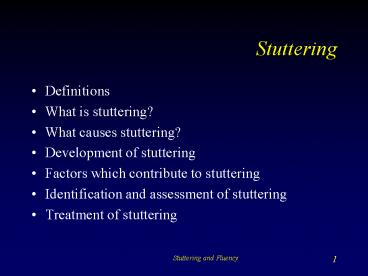Stuttering - PowerPoint PPT Presentation
1 / 17
Title: Stuttering
1
Stuttering
- Definitions
- What is stuttering?
- What causes stuttering?
- Development of stuttering
- Factors which contribute to stuttering
- Identification and assessment of stuttering
- Treatment of stuttering
2
Definitions
- Fluent speech
- Speech that is easy, rapid, rhythmical and evenly
flowing. - Disfluent speech
- Marked by repetitions, interjections, pauses and
revisions. Not all the uncommon. - Stuttering
- Abnormal number of disfluencies that are
physically tense. Stuttering interferes with the
ability to communicate and may lead to negative
feelings of self. - Cluttering
- Common in young children. Often confused with
stuttering.
3
What is stuttering?
- Primary stuttering behaviors
- Repetitions
- Prolongations
- Blocks
- Secondary stuttering behaviors
- Counterproductive compensatory movements which
can be as distracting as primary behaviors. - Show video clip 13.1
4
What causes stuttering?
- Stuttering is not
- A nervous reaction
- Parents over-correction of childs cluttering.
- Psychological disorder
- Stuttering is caused by . . .
- When know, let me know. Although, it is thought
to be a combination of internal factors (e.g.,
neurological and cognitive) and external
conditions. May be a link to dopamine levels in
brain.
5
Development of stuttering
- Early stuttering
- Cluttering is not uncommon. It does not become a
problem until these behaviors become chronic. - Genetic influences
- Three to four times more common if a family
member stutters. - Environment
- Stressful communication demands
- General emotional stress. External and internal.
- Demanding communication expectations.
6
Identification and evaluation of stuttering
- Interview and case history
- Speech sample
- Screening for other disorders
- Feelings and attitudes
7
Interview and case history
- Cultural influences
- Communication demands vary across cultures.
Stuttering tends to be more prevalent in
societies with high communication demands. - Genetic influences
- Tends to be more common if relative stutters
- Course of the disorder
- When did it first occur?
- Has it gotten better or worse?
- What situations does it become worse?
- Should also interview parents, family members,
significant others, etc.
8
Speech sample
- Conversational speech
- Reading
- Attempt to determine . . .
- Contexts where stuttering occurs
- Nature of specific stuttering behaviors
- Check out figure 13-1
9
Screening for other disorders
- Hearing
- Cognitive
- Oral mechanism
- Voice quality
- Articulation and language
10
Feelings and attitudes
- Often uses specific questionnaires to determine
the extent to which negative attitudes and
feelings contribute to stuttering behavior. - Can be used to help determine best approach to
stuttering.
11
Treatment
- Stuttering modification
- Fluency shaping
- Speech Easy Device
- Working with parents of young children
12
Stuttering modification
- A person changes the way they stutter.
- Insert table 13-4 (Van Ripers approach to
stuttering modification) - Insert video 13.3 and 13.4
13
Fluency shaping
- Teaching a new way of speaking that is free of
stuttering. - May include . . .
- Slower rates of speech
- Relaxed breathing
- Easy initiation of sounds
- Smoother transitions between words
14
Electronic devices
- E.g., speech-easy device
- Looks like a hearing aid
- Uses phase shifting and delayed auditory feedback
- 2/3 show significant improvement
- Effect wears off in some people
15
Medications
- Possible link to dopamine levels in brain.
- Drugs that reduce dopamine can reduce stuttering
by 25-60. - Side effects (dizziness, sluggishness,
drossiness, anxiety) - Long term effects not known
- Drugs that increase stuttering (e.g., Ritalin)
can can cause Tourette Syndrome behaviors.
16
Working with parents of young children
- Parents are taught to
- Increase factors which improve fluency
- Stress free environment
- Positive comments
- Slower speech
- Decrease factors which increase stuttering
- Rapid rates of speech
- Excessive questions
- Pressure to respond rapidly
- Whenever possible parents should attend treatment
sessions
17
(No Transcript)































